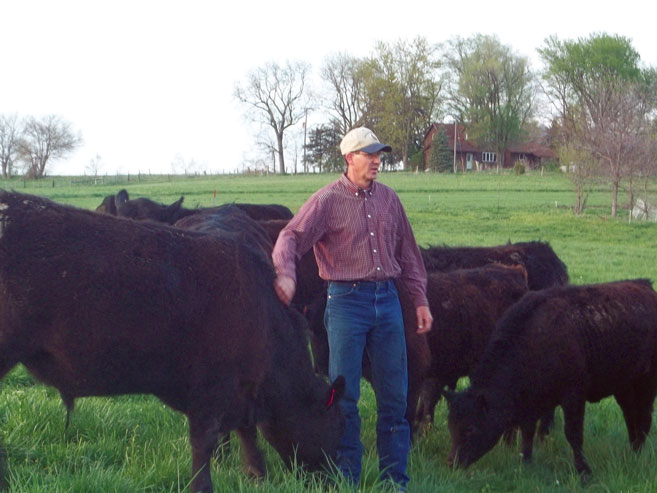A Practical Farmer: Matt Russell & Coyote Run Farm
Matt Russell is the only academic I know with calluses on his hands. He’s also the only farmer I know with an office at a law school. A sociologist by training and a farmer by heritage and avocation, Matt is a quiet voice of reason in an increasingly contentious debate about modern farm practices. Matt is on the staff at Drake University Agricultural Law Center where he’s responsible for projects relating to improving opportunities in Iowa’s agricultural and rural economy. He’s been with Drake since 2006, and has worked on issues concerning retail agriculture, land tenure, conservation, climate change, farmer veterans, rural development, state food policy, and federal farm policy.
And as if that isn’t enough, Matt and his husband Patrick Standley operate Coyote Run Farm, a 110 acre farm in rural Lacona. They market fresh produce, eggs, and grass-finished beef at farmers markets and other local outlets. Matt and Patrick do what they call retail agriculture. Everything that comes off the farm is a branded product that is sold primarily to single individuals and families. Some goes to restaurants. Most of their clients are in the Des Moines market or local in Marion and Warren Counties.
Matt is optimistic about the future of agriculture. He believes that we are now at a critical juncture in history, where lots of things are coming together that will help bring about change to a more sustainable future. The local food movement is maturing he says, more voices are being heard, and consumers are demanding that farmers start listening to them. And then there is that ornery climate change thing, a nearly dead Gulf of Mexico, and a water quality issue so severe the Des Moines Waterworks is suing three upstream counties for the nitrates they are putting in the water.
Matt doesn’t accept the Madison Avenue hype big agricultural organizations push about farmers being the ultimate conservationists and stewards of the land. “It’s disingenuous to act like all farmers are great stewards, just like it is to say all are terrible ones.” He says while there many farmers in the state who are both phenomenal farmers and stewards of the land, the bad actors need to be called out. He’s clearly frustrated when describing land in his own neighborhood. “It was a side hill that should never have been planted. It had been a farmstead, but had grown back to trees. Now there are tree piles four stories high, and it’s been planted to beans. It’s outrageous.”
He also had criticism for some in the local food movement. “We need a more mature local food movement. Some people think that if we just eat local, we can get rid of industrial agriculture. That’s naive. We need both.” Matt’s referring to the fact that farms produce much more than food--fiber, biofuels, medicinals, and more.
He thinks that the key to success for all -- modern industrial agriculture, the local food movement, and our rural communities is diversification. “The local food movement creates opportunities for diversification, both in terms of what we eat, but also in terms of who’s producing food. More families, different people coming into our rural communities. Retirees, immigrants, the average household can add something to the income stream. We’ll have a diversified income stream and markets with more local food.”
Matt says “We need all of agriculture. We need highly industrialized, commercialized, and capitalized ag. And we need smaller more efficient farms too.” He says that we also need to question the assumptions of efficiency that come with conversations about big ag. “The appearance of efficiency breaks down when you recognize that big commercial operations are using public resources and externalizing costs. They look more efficient than they really are.”
To Matt, the question becomes, how do we take what we are learning with local foods, and use it, not to replace industrial ag, but to help make it more resilient? He says we need to make the argument for diversification, that animal health and wellbeing matter, as does soil and water quality. We must REQUIRE that modern industrial ag be more responsible to what the world needs, and to internalize costs.
I asked him if the Des Moines Waterworks lawsuit against the upstream counties was an attempt to make operations internalize costs. He nodded. “Increasingly we’re going to see pressure put on agriculture to either pay for some of the external costs or to eliminate those costs. An example is nutrients leaving farms and contaminating downstream water. In many ways, that’s what the lawsuit is about, holding someone accountable for the costs being paid by ratepayers in and around Des Moines.”
The last couple of times Matt and I got together, he was critical of how modern agricultural research is funded. He insists more public money needs to be invested in disinterested agricultural research. I asked him for some specifics, and the following quote is long, but I want to use his words. “We must allow and fund our scientists to pursue ideas that are not solely connected to products from agribusiness. Much funding for research today comes from corporations. The purpose of that funding is to grow the profits of the company, which is fine, but if we’re going to have a resilient agriculture that can solve the complex problems the world is going to need to solve by 2050, we’ve got to DO science in the public interest and not just USE science to serve corporate profits. In the last 20 years, we’ve seen science funded by agribusiness increase, while independent publicly funded agricultural science has withered on the vine. And then, for much of the public money that is available, rather than going to independent projects, it’s leveraged by corporations for their purposes. For example, while seed companies might be interested in testing corn or bean resistance to herbicides and pesticides, who is testing the long term impacts on soil health, and pollinators, birds, frogs, and biological diversity in general? There’s very little money to do that research and if a scientist does try to pursue it and it exposes risks, say a chemical company doesn’t appreciate, that research might be putting the scientist’s other funding in peril. Very few people are doing that research because the independent money isn’t available and there are potential downsides to that scientist’s career if he or she decides to pursue an idea that might threaten an existing product or one that’s in development. We’ve literally lost a generation of agricultural innovation because of this dynamic.”
Wow.
I gave Matt a magic wand, and asked him to create a sustainable future for agriculture in Iowa. He didn’t have to think very long to come up with what he would like to see. “I see an Iowa with more crops in the rotation, more livestock on the land, and the livestock more dispersed across the state. We need the same number of hogs on more farms. We need more cow-calf operations on land that’s less productive for corn and beans. That land is great for cattle. We need the manure dispersed and used.”
He says that we can deal with global warming and help with soil and water quality at the same time--by getting more carbon into the soil. “It’s going to take more research and investment, some tillage, some no till, animal agriculture, cover crops, and more. If we can increase the carbon in our soils, we are going to have better water quality, better soil health, more productive soils, and probably see yields go up, and I think we will likely see the needs for industrial fertilizers go down.”
More diversity, more crops in the rotation, and animals spread more widely, will help. He adds, “if we can get more organic matter in the soil, and really pull carbon out of the atmosphere and into the soil, and if we do this and do it well, markets will come to us to support that kind of agriculture. We need to do this well, and policymakers need to consider mechanisms for paying the farmer for pulling carbon out of the air and putting it into the ground, where it’s needed.”
He says there will be a big pushback from big ag. “They’ve made big investments, and resistance is natural. But they need to listen to the voices of people, especially young people who are interested in where their food comes from, and what goes into making it. We need lots of policy work, lots of public research, consumer demand, and markets to deliver good healthy food and other ag products wisely in a sustainable way.”
“But big ag needs to listen. Their approach of ‘Trust us, shut up, and eat it,’ doesn’t work anymore.






